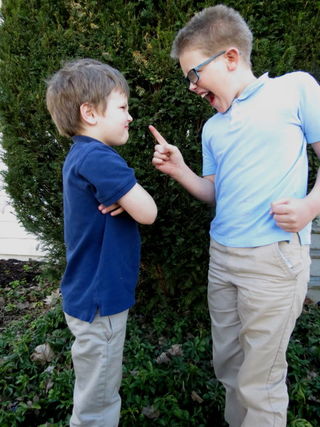Family Dynamics
Your Kids Being Monsters With Each Other?
Teach them how to solve their conflicts fairly.
Posted March 25, 2019
A mother of three children—9, 7, and 6—recently said to me, “I find that my kids can be polite and respectful and even kind when they’re interacting just with me, but they can be absolute monsters with each other!”

Even if kids aren’t being “absolute monsters” with each other, sibling conflicts of one kind or another are often the chief disruptor of peace in the home. But it doesn’t have to be that way.
Many of those conflicts are caused by a perceived unfairness—and the fact that kids don’t know how to settle conflicts fairly. Nobody ever taught them.
Let’s look at some ways to do that.
Start with Mediation
It helps if you mediate conflicts at first in order to give kids guided practice in solving conflicts fairly. Even after they get the hang of it, parental mediation may be needed for some conflicts.
An example from our family: When our older son Mark was 13, he’d sometimes have four or five friends over after school to play “Dungeons and Dragons,” a popular game at the time. His younger brother Matthew was just 8 years old and didn’t get to be a player, but because he and Mark did a lot of other things together despite their 5-year age difference, Matthew expected a piece of the D & D action. He hovered around the table, taking an intense interest in the game and reacting to people’s moves.
Thirteen-year-olds, however, want to do their own thing without somebody’s little brother looking over their shoulder, and Mark’s friends asked him if Matthew was going to do this at every game.
So Mark asked Matthew to please do something else when he had his friends over for Dungeons and Dragons. That didn’t go down well with Matthew—he complained that it wasn’t fair.
Before the next D & D game, I mediated a “fairness meeting” between the two of them. “Let’s try to solve this problem in a way you both think is fair,” I said.
I asked them each to tell their feelings. Next, I asked them both to say how the other person felt. When I felt they understood each other, I said, “What would be a compromise that you both think is fair?”
We brainstormed the possibilities. In less than 10 minutes, we had a solution they agreed was fair:
Matthew can be in the room while the game is going on, but has to sit in the big chair at the other end of the family room—close enough for him to still hear the conversation—and not say anything. If he does, he has to leave the room.
Problem solved. Matthew never had to leave the room, but he eventually lost interest and did other things.
What if the fairness discussion doesn’t produce an agreed-upon solution on the first try? Focus on whatever progress you've made and plan next steps:
“OK, we’ve made a start toward working this out. Let’s think some more about what would be a fair way to solve this. When should we continue our discussion?”
“Don’t Take My Stuff!”
A fairness meeting doesn’t always have to produce a compromise. Sometimes one person is in the right, and the discussion clarifies why that person has a legitimate grievance. A mom gives an example of this:
"The biggest source of conflict in our home was my 11-year-old son Sam going into his 16-year-old sister Jen’s room and taking something without her permission. She’d get furious with him when she saw him using or playing with something of hers. She told him in no uncertain terms that she didn’t want him messing with her stuff, and I talked to Sam as well, but it kept happening.
"The next time she got angry with him about this, I sat them down and asked her to help her brother understand why it upset her so much. She explained her feeling that it was disrespectful and an invasion of her privacy. I asked Sam to say back what she was saying to show that he understood her feelings. I’m not saying they never had a problem about this again, but things were much better after that."
Have a Talk-It-Out Space
With time and practice, kids can learn to use a fairness approach to solving conflicts without our mediation. To help that happen, I suggest having a “talk-it-out space” in the house where your kids can go to sit down and work out a fair solution to a conflict.
In some classrooms, the teacher has a Peace Table where kids go to solve their disputes. They sit on opposite sides of table and put both hands, palms down, on the table—which keeps either person from pointing an accusing finger.
Other classrooms have a Solutions Circle marked out with red electrical tape on the floor. Kids having a conflict go to the circle and stay there until they’ve worked out a fair solution, which they then tell the teacher.
You can use any of these approaches; the important thing is to have a dedicated space for conflict resolution.
Propose your talk-it-out space at a family meeting. Explain that you’d like to try it out as a process for solving conflicts and having more peace in your home. Emphasize that creating a happier, more peaceful family is everyone’s responsibility, not just the parents.’
I suggest you print steps like the following on a poster board and hang it in your talk-it-out space:
TALK IT OUT
1. Calm down (take 3 deep breaths, or count slowly to 10).
2. Take turns saying what you think the problem is.
3. Show understanding (say back what the other person said).
4. Take turns saying what you think is fair.
5. Agree on what you think is a fair solution, and tell Mom or Dad.
In the beginning, you’ll need to patiently coach kids through these steps, helping them understand each one and not skip any. Then observe from a distance to see how they do on their own.
With enough practice, they'll get better. Think of all the practice it takes them to master a skill in a sport. Solving conflicts is even harder because strong emotions are usually involved. So don't give up.
In elementary schools where every classroom has a “talk-it-out space,” children have made remarkable progress in developing the skills of speaking, listening, and solving conflicts fairly—assets that will help them all their lives.
You'll be doing your kids a great service if you help them develop these skills. And over time you'll reduce the sibling battles that create unnecessary unpleasantness in the home.




